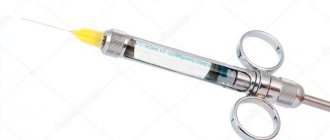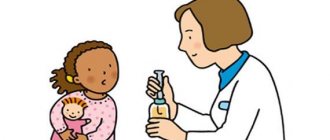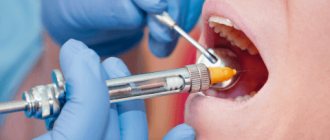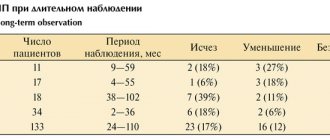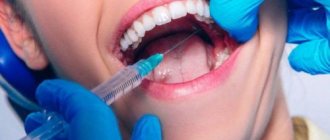Types of combined anesthesia
- Neuroleptanelgesia. The method involves a combination of antipsychotic and narcotic drugs. In this case, antipsychotics have an inhibitory effect on the nervous system, and narcotic substances enhance the analgesic effect. The drugs most often used are: etapyrazine, aminazine, droperidol and haloperidol;
- Intubation anesthesia. The substance enters the respiratory system using a laryngeal mask. Due to its complexity, this method is also not used often.
Ataralgesia. The combination of analgesics and tranquilizers gives a calming, relaxing and analgesic effect. The most commonly used tranquilizer components are: Relanium, Elenium, Phenazepam and Grandaxin.
Types of sedation in dentistry
There are quite a few ways to administer relaxing drugs, but only a few of them are used in dental clinics:
- Inhalation
. The most common mind control technique. The advantages of dental treatment under sedation through inhalation: quick effect, the process is easy to control, consciousness is restored in a very short period of time. The most common use is nitrous oxide. It has a relaxing effect, reduces motor activity and has some analgesic properties. Subject to the rules of supply and percentage of gases, there are practically no side effects. - Injection
. The drug is administered once, as an injection or gradually, through an intravenous infusion system. The most well-known drugs are profopol and medazolam. Their hypnotic effect allows dental treatment to be performed while you sleep, while maintaining basic reflexes and spontaneous breathing. Recently, dexmedetomidine has been increasingly used because it does not lower blood pressure. - Oral medication
. If the patient is afraid of the needle, but calmly takes the pills, they can be used. - Intranasal dispersion
. An anesthetic is sprayed into the nasal passages. So the drug, through the taste buds, immediately enters the brain. Quick effect, bioavailability, central action and ease of use make sprays very popular.
Introduction of anesthesia: step-by-step description
- Introduction to a state of anesthesia.
- Analgesia. The duration of the stage is approximately 4-5 minutes. At this time, the patient's pain sensitivity decreases, but all reflexes and stable body temperature are preserved.
- Excitation. The duration of the stage is 7 minutes. During this period, the following are observed: instability of pulse and temperature, increased salivation and muscle tone.
- Maintaining anesthesia. This stage is conditionally divided into several stages-levels:
- Surface. The following are noted: normalization of pulse and pressure, muscle tone with complete blocking of sensitivity;
- Easy. Characterized by rhythmic breathing and muscle relaxation. At this point, the doctor can already begin initial, superficial manipulations;
- Full anesthesia. There is complete relaxation of the muscles, rhythmicity of the pulse and breathing, and a slight decrease in blood pressure;
- Ultra-deep anesthesia. Characterized by shallow breathing, weak pulse and low blood pressure.
After completing the manipulations, the supply of the anesthetic substance is stopped and it is replaced with pure oxygen for 2-3 minutes. It is during this interval that the patient awakens, and after 30 minutes his complete recovery is observed.
Consequences of sedation in dentistry
Specific problems with the use of mind control drugs depend on the route of administration and the mechanism of action of the drugs.
At the beginning of the procedure, you may experience increased activity, physical restlessness, talkativeness, and increased sociability.
A common symptom is an obsessive cough. This problem can be stopped by reducing the dose of the drug. Complications after sedation can appear both immediately and in a delayed period.
Possible short-term complications
- Breathing disorders (slow breathing, lack of oxygen);
- problems with hemodynamics (drop in blood pressure, irregular heart rhythm);
- depression of the central nervous system;
- intestinal dysfunction, vomiting.
Delayed symptoms
- Development of psychoses;
- hallucinatory syndrome;
- paralysis.
Is sedation dangerous? No, if it is carried out by an experienced doctor who has undergone special training, and the clinic is equipped with everything necessary to eliminate the consequences. But this is not a magic pill that can be prescribed to everyone without thinking about the consequences.
The main nuances and disadvantages of treatment under general anesthesia
There are a number of disadvantages in the question “ is it possible to treat teeth under general anesthesia ”:
- There is an increased load on the pulmonary and cardiovascular systems;
- Post-anesthesia symptoms are common: nausea, vomiting and weakness;
- Due to limited time, it is possible that the selection of filling material is insufficiently high-quality and the treatment process is disrupted, which consists in the impossibility of preserving the anatomical forms of the tooth being restored.
All manipulations when working with general anesthesia are carried out by: a dentist, a nurse and an anesthesiologist. Throughout the procedure, the operation of all vital systems is constantly monitored.
Stages of sedation
- Easy
. The patient is in a state of relaxation, but is awake and makes contact with the doctor. Although his reactions and coordination are slightly reduced. This type of sedation is also called superficial. - Average
. A state of consciousness in which patients respond to tactile stimuli, all functions are preserved, reflexes work, and there is interaction with the doctor. - Deep
. The patient reacts only to strong stimulation; the patient does not respond to a call, but the cardiovascular system works normally. Breathing may become irregular
The next stage is complete anesthesia. With it, there is no reaction even to strong painful stimuli. Respiratory support is often needed.
Premedications
- Sedatives of plant origin (Corvalol, tinctures of motherwort and valerian). Necessary to reduce excitability.
- Neuroleptics (droperidine).
- Anticholinergic drugs.
- Opioid drugs (promedol and morphine).
The selection of the listed drugs is made by the attending physician, based on the specific situation and individual characteristics of the small patient. There must be a compelling reason to use general anesthesia in children.
Sedation in pediatric dentistry
Up to 50% of children
[1] hide dental problems due to fear of treatment. This affects their quality of life and oral health both in childhood and when they grow up. Therefore, the use of mind control measures when providing dental care to children is justified, subject to strict adherence to rules and regulations. Most often, medicated sleep during dental treatment in children is achieved using nitrous oxide, but there are studies that have confirmed the effectiveness of the use of other medications. It is worth remembering that sedation should be used only when no other method of dental treatment for a child does not work. This will help avoid harmful consequences.
Is it possible to remove teeth under general anesthesia?
Tooth extraction under general anesthesia requires compliance with all the previously listed measures and is carried out taking into account all individual nuances. Contraindications are given the greatest attention. If there is an excess of possible risks over the expected benefits, the use of general anesthesia is replaced by other measures.
Contraindications to sedation
Like any medical procedure, depression of consciousness has contraindications. There are very few of them. The only absolute contraindication is myasthenia gravis (muscle weakness). The remaining states are relative. These are drug or alcohol intoxication, hypotension, a full stomach, a disorder of consciousness that prevents interaction with the patient, pregnancy, a condition after an acute heart attack/stroke. An opinion on the possibility of carrying out this procedure can only be issued by a general practitioner and an anesthesiologist.
The choice of method may also be limited. Thus, inhalation methods are contraindicated for sinusitis and other diseases of the upper respiratory tract. The doctor must know about all diseases in order to select the appropriate drug for a particular one in order to use medicinal sleep in dental treatment without consequences. That is why it is important to treat teeth in a clinic with modern technical facilities. Typically, such dentists employ experienced anesthesiologists and have equipment for first aid.
Application of local anesthesia for dental treatment
This type of anesthesia is most often used in pediatric dentistry, as it is performed without an injection. The doctor performs superficial anesthesia of a specific area of the mucosa using a gel or spray.
Since sensitivity in deeper tissues is preserved, local anesthesia is used only for certain dental procedures:
- removal of dental plaque;
- removal of teeth with high mobility;
- disinfection of the mucous membrane before introducing deeper anesthesia;
- pain relief after injection.
Cross allergic reactions between anesthetics:
- Among group I local anesthetics, intragroup cross-allergic reactions are often observed. In this case, drugs from the second group are prescribed. Exceptions: lidocaine - novocaine; lidocaine - benzocaine.
- They are also possible between group II drugs with a similar structure (lidocaine, prilocaine and mepivacaine).
- Until recently, it was believed that with intolerance to local anesthetics Group I
Group II
drugs can be used due to the absence of intergroup cross-reactions. However, there are reports of the possibility of developing allergic reactions, including anaphylactic reactions, to lidocaine (xicaine) with intolerance to novocaine, as well as to benzocaine (anesthesin) with intolerance to lidocaine.
It should be borne in mind that many side effects of local anesthetics, for example, swelling at the injection site, arterial hypotension, tachycardia, collapse, occur in both allergic and non-allergic reactions to these drugs. Allergic reactions when using local anesthetics are more likely to develop to additives
(bisulfite and parabenzoic acid, etc.) included in their composition.
Allergy to local anesthetics
Allergy to local anesthesia is extremely rare and in practice it is not possible to detect it using immunological tests.
The reaction to local anesthetics is pseudo-allergic in nature and is associated with the mechanism of degranulation of mast cells and basophils upon contact with Toll-like receptors on their surface. In terms of external manifestations, pseudoallergic reactions are no different from true intolerance to local anesthetics. They can be local or generalized. Appear on the second to fifth administration of the drug and are manifested by urticaria, edema, anaphylaxis or an attack of suffocation. The problem of modern medicine is related to the fact that reliable laboratory tests for determining pseudoallergic reactions have not been developed.
Much more often in practice there are allergies to anesthesia to additional components of the solution or packaging.
One of the leading places is occupied by latex allergy. Some manufacturing companies use latex to make pistons and plugs for glass cartridges. Doctor's gloves are also made from it. Therefore, if you have noticed a reaction to medical gloves, warn your doctor about it. The RuDenta clinic uses exclusively anesthetics in a cartridge with latex-free rubber.
Some manufacturers add stabilizers, preservatives and vasoconstrictors to the anesthesia solution.
Vasoconstrictors include adrenaline, norepinephrine and fellipressin. It is to these substances that we owe the strength and duration of anesthesia. They also prevent the rapid entry of the drug into the bloodstream and thereby reduce its toxic effect. However, there is also another side to the coin. They are oxidized too quickly by atmospheric oxygen. Therefore, sodium bisulfite must be added to their solutions. It reacts more actively with oxygen and thus prevents the oxidation of active substances. Bisulfites can cause allergic reactions and bronchospasm, more so in patients with hypersensitivity to sulfur-containing drugs (bronchial asthma). In such cases, the drugs of choice will be similar anesthetics without a vasostrictor: mepivacaine (Scandonest, mepivastezin) or ultracaine D.
An allergy to local anesthesia can develop to parabens , a preservative for drugs in ampoules and in some carpule anesthetics (Ultracaine D-S). Parabens are widely used in the food industry and in toothpastes.
Drugs used for local anesthesia
Groups of local anesthetics | |
| Group I: Ester-type | Group II: Amide type |
| Procaine (novocaine hydrochloride) Tetracaine (dicaine) Benzocaine (anesthesin) Butethamine Chloroprocaine Cyclomethicaine Proximetacaine Bencaine Oxetakaine. | Lidocaine (xycaine, xylocaine, lignocaine) Trimecaine (mesocaine) Prilocaine (cytanest) Mepivacaine (carbocaine, scandonest, mepicatone) Bupivacaine (marcaine) Levobupivacaine Ropivacaine (naropine) Etidocaine (duranest) Articaine (ultracaine) Pyromecaine (bumecaine) Cinchocaine ( sovcaine) Dyclonine Pramocaine Ubistezin and others. |
In fact, most adverse reactions to local anesthetics are not associated with true allergic reactions, but with vegetative-vascular disorders, toxic and hysterical reactions, as well as side effects of additives included in some anesthetics.
The true incidence of allergic reactions to local anesthetics is unknown. They are described by some authors as rare events, and their incidence is less than 1% of all adverse reactions with local anesthetics.
